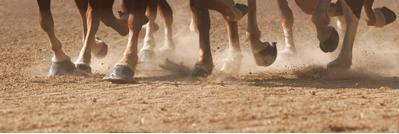Don't think of heel concussion as a problem; it's a part of the normal footfall as a hoof moves through its stride. But excessive heel concussion is a different matter — with the sneaky potential to get lost amid concerns about navicular syndrome and other causes of palmar pain.
Asked about excessive heel concussion, equine veterinarian Tracy Turner says, "In some of the cases I've seen, the horses are sore enough that they almost act like they have a fracture. The bars and the heels and the laminae in the area become so inflamed that it becomes incredibly painful for the horse."
If not caught early and remedied, pain from excessive heel concussion can change the biomechanics of the foot. Turner, a member of the International Equine Veterinarians Hall Of Fame who practices in Elk River, Minn., says the horse starts loading the foot differently, which can damage the navicular region over time.
From a medical standpoint, heel concussion is not a problem until it creates bruising or damage to the laminae or other, deeper structures. "Once it becomes painful, the horse will respond to the pain. Clinically, you will see signs very similar to any other type of palmar foot pain such as navicular syndrome. That will be caused by the horse landing on his toe to get away from the pain," Turner says.
Common At The Track
Excessive heel concussion is particularly common in racehorses, due to the speed of their stride and the often-hard tracks on which they run. Turner says the combination can lead to deep bruising, and that enough deep bruising and damage to the laminar tissue might be one reason some racehorses have trouble growing heel after their racing career. "That's speculative, but where the actual horn grows from has been damaged, so it could be hard to grow a good foot," he adds.
Farrier Steve Stanley of Versailles, Ky., shoes regularly at Standardbred tracks in the area and agrees that excessive heel concussion is a common problem. "It's the easiest thing to fix, yet among the most common causes causes of lameness at the racetrack," he says.
The problem most often occurs with racehorses when the dorsal wall becomes too full and the shoes are too short and stay on too long, forcing the hoof — including the heel — to migrate forward, Stanley says. As the wall at the toe becomes too thick, the foot is no longer balanced properly. The imbalance changes the way the hoof handles the load and leaves the heel with too little support to absorb the extra-hard concussion of racing, he says.
The changes adversely affect the hoof-pastern alignment and can lead to a broken-back orientation between P3 and P2.
"I think this is the point when serious damage begins to occur," Stanley says. "The foot can develop an underrun heel, with corns and bruising in the heels. The horses will start striding differently, change their gait to become more comfortable, or even become very lame, not just a little off. The horse just cannot perform up to its potential."
Know The Signs
An inexperienced farrier or one who is not looking for the problem might find the first indication of excessive heel concussion when he or she trims the foot and uncovers corns, or bruising in the heel. However, the hemorrhaging is evidence of damage that occurred weeks earlier, Stanley says.
The problem can be discovered much earlier. Stanley says farriers should watch for short-striding as an early sign of possible heel concussion. "You can definitely tell that's happening if you're watching the horse move or perform, which you should be doing if you want to give your best input toward a solution," he says. "Often the trainer or the rider will bring it to your attention."
Another early indication of excessive heel concussion is an overly strong pulse or throbbing in the foot, right below the ankle, a sign that the body is pumping blood to the area to cope with an injury, he says.
Stanley believes farriers should learn to check for a pulse there and teach themselves what is normal and abnormal. He also recommends the use of heel testers.
Stanley cautions that heel concussion problems can be confused with heel pain of other sorts, including navicular syndrome. To differentiate between a heel concussion problem and other sources of heel pain, the first thing to do is evaluate the foot, he says.
"If you can see mechanical problems with the balance of the hoof, it's more likely to be heel concussion than true navicular syndrome," Stanley says. "Take the time to look at the foot from the side and watch the horse stride. Check the balance of the foot; balance problems in the foot often create bruising and are a big indicator."
Thorough Testing
Turner suggests a number of methods a farrier can use to pinpoint soreness from excessive heel concussion. Hoof testers can be reliable, and a farrier should expect to find more pain in the heels instead of deeper in the hoof.
A wedge test could also be helpful, putting pressure right on the heels and making the horse stand on them. This should create more pain in the heels than it does over the frog, which would indicate a deeper pain, he says.
Also, lightly tapping on the hoof wall with a hammer can help locate the pain and inflammation, which would be similar to focal laminitis in the wall or in the bar.
And if heel concussion is a problem, driving in the heel nails during shoeing would probably be more painful than what would be expected, he adds.
But Turner warns that once a horse becomes sore and starts showing lameness, there might not be any indications specific to excessive heel concussion.
"If the farrier doesn't see a big bruise, and the only thing the horse presents with is a reluctance to load the heels because they hurt, I don't know how the farrier can differentiate it. That's when he needs to advise his clients to call in a vet," he says. "The heels might not be the problem. It could be a deeper injury that the farrier has not recognized."
The vet will probably repeat the examination process with hoof tester, wedge test and perhaps some type of imaging such as X-rays, Turner says.
A thermal imaging examination of the hoof could help pinpoint inflammation in the wall or other shallow location in the foot, though the technique is less precise if the injury is deeper within the hoof capsule, he adds.
A vet also has the option of confirming the diagnosis with a palmar nerve block, which would eliminate all pain coming from the lower heel. " If it doesn't, you know that's not what you're dealing with," Turner says.
Back Up The Heel
Correcting the hoof problem to eliminate excessive heel concussion involves moving the toe back and providing heel support, Turner says.
However, using a longer shoe can be a problem in itself at racetracks, where owners and trainers worry about having a horse grab its front shoes during competition, he notes.
Certain types of pads can be helpful, he says, including rim pads to lessen the concussion.
He adds, "It might have to be a compromise where I need to support the heel and add protection with acrylics or urethanes, or maybe even down time. I have heard of people doing turndowns, bending the heels of the shoe down to create a mild floating of the heels, but that's not done very often."
He warns against the use of toe grabs, which increase concussion on the heels, he says, and recommends using a rim shoe. "There are quite a few possibilities, so you work with what you have," he says.
Stanley says bringing the hoof into balance is often enough to help considerably. Next, redistribute the force of the landing to lessen the impact on the heel.
"I like bar shoes or Circuit plates," he says. "Heart bar shoes work well, but can change a horse's gait.
Anything that spreads the force over a bigger area has to lessen the intensity of impact. That is simple physics, and the horse will prove it in short order through improved performance," Stanley says.
On racehorses, Stanley prefers a Circuit plate, a thin aluminum plate that goes under any kind of shoe and doesn't affect the way a horse lands.
"The ground-bearing surface of the shoe is largely unaffected," he says. "A bar shoe or a heart bar shoe stops a little quicker without much slide when it hits the ground.
"This is because of increased ground surface at the heel. It also adds weight in the heel, and some horses don't race as well that way," Stanley says.
"Racehorses need a little bit of slide when the hooves hit the ground because of the velocity at which they're moving," he adds.
The better approach is to prevent excessive heel concussion by focusing on hoof balance to eliminate the mechanically induced pain that is often seen, Stanley says.









Post a comment
Report Abusive Comment